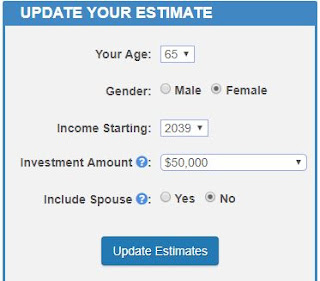Annuities Are Insurance Products And Subject To Plenty Of Hidden Costs.
With thanks to the Sun Life Annuity Calculator, the above example is for a male (life expectancy of 87, vs. a female who has a life expectancy of 90):
For simplicity (a straight life annuity): If you put $500,000 of non-registered money into an annuity at age 65, it will pay you $30,657 per year, before tax and $28, 548 if your marginal tax rate is 35%.
For the ladies, because you are expected to live longer: only $27,816, before tax.
Most importantly, men, inclusive of fees and commissions and all the other costs associated with an annuity, the annual compounded rate of return (before tax) to age 87 (22 years) is 2.77% (using simple future value calculation).
Ladies, who get to 90, it is 2.72% (annually).
Men who get to 100, 5.03%.
Ladies who get to 100, 4.28%.
In these examples, there is no inflation protection, so your real return (after increased cost of living of approx. 2.5% per year) is rendered pretty light.
Remember, if you depart this world early (before your expected to), nothing goes to your beneficiaries: if a Male dies at 82, the compound annual return goes down to 0.46%, for females, yes, you guessed it, a negative -0.41%. Yikes.
Peace of mind from the insurance companies is not a cheap prospect.
What about those new Advanced Life Deferred Annuities (ALDA) that were recently announced in the latest budget?
In case you missed it, CBC covered this a couple of weeks ago and an astute and inquisitive client asked me what I thought.
Using the example in the article: a 65 year old woman who has $500,000 in retirement savings.
The ALDA would, apparently give her $28,000 per year at age 85 with a payment of $50,000 at 65.
In my communication with the writer of the article, Aaron Saltzman, he passed on the calculations he received from Prof. Bonnie-Jeanne MacDonald.
My initial impression is that the estimates are high (for this example) because they appear to be using 5% as the nominal interest rate for their growth calculations and the payout of $28,000 per year from age 85 ultimately leaves the Life Insurance company who underwrites this a little too close to the break-even.
Since we are not going to see any of this until 2020, Canadian Lifeco's do not have these in their lineup yet, or I could not find them if they do.
But I did find a U.S. Website with a calculator and plugged in the same values and timelines as Mr. Saltzman's example that kicked out a result that appears to be more realistic to me:
Initial monthly income of $1,491, or $17,892 per year.
We shall see what transpires from this with the Canadian Lifeco's when they bring this product to market, but I would not get too excited just yet.
(co-authored by Bianca Tomenson, CFP)




No comments:
Post a Comment